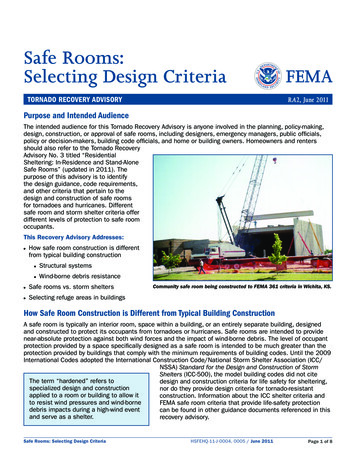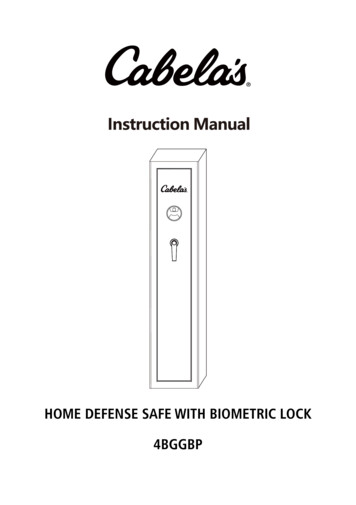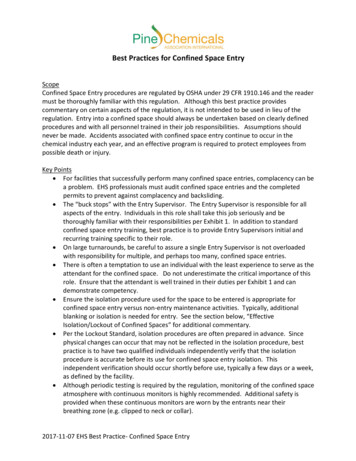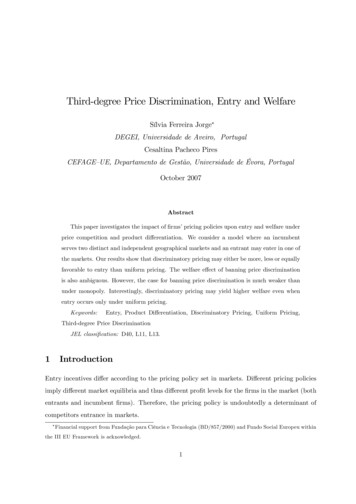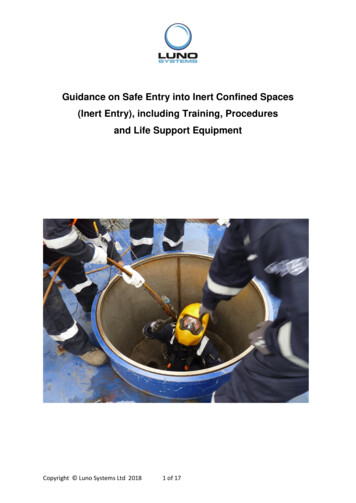
Transcription
Guidance on Safe Entry into Inert Confined Spaces(Inert Entry), including Training, Proceduresand Life Support EquipmentCopyright Luno Systems Ltd 20181 of 17
Contents1.2.3.4.5.6.7.8.9.IntroductionDocumented ProceduresRoles and ResponsibilitiesHazards and Risk AnalysisSurroundings and Work EquipmentEquipment to provide safe entryRescue PlanningSummaryBibliographyCopyright Luno Systems Ltd 20182 of 17
1. IntroductionConfined Spaces are inherently hazardous places of work and exist in many industries. Insome industries, particularly the petroleum or oil/ gas industry, these are intentionally floodedwith an inert gas to ensure the vapour space is too low to support combustion. Some areasof the world will carry standards and regulations which cover this work, particularly the USA,and the UK/ Europe, and many other countries have adopted these best practices whichhave been derived through experience in the workplace.Normal minimum levels for safe entry into confined spaces are 19.5% Oxygen and less than10% Lower Explosive Limit of the flammable gas present, although these may vary slightlydepending on region and the site’s specific procedures.In the case of inerted atmospheres, a space which must be entered, the Lower ExplosiveLimit should be maximum of 10%, and a maximum of 4% Oxygen to prevent fire orexplosion. Due to the low oxygen levels there are special requirements on this work whichrequire additional safe practice. If after entry into this environment the oxygen levelincreases to 5% then the workers should be removed from the inerted space. These shouldsupport the local regulatory requirements and not conflict.An inerted confined space should always be classed as requiring Permit to Workprocedures, and Immediately Dangerous to Life and Health (IDLH). However due to the lackof oxygen this environment is considerably more dangerous than other confined space whichare classed as IDLH.The loss of respiratory protection in these conditions can result in rapid asphyxiation.Exposure can result in immediate incapacitation of normal consciousness, rendering selfrescue impossible. For this reason, extra redundancy should be built into the respiratoryprotective system with normally a minimum of three air sources of supply to each user.Consideration should be given to the area where the gases are exhausted from the inertedconfined space, as there is the potential for exposure in these areas of contamination ofnearby plant areas.On refineries, there is the potential if Carbon Monoxide enters the inert gas stream for theCO to combine with nickel from catalyst or stainless steel and to form gaseous NickelCarbonyl which is extremely toxic, with concentrations of a few ppm for short durationscausing severe acute symptoms and more than 30ppm for 30 minutes can be lethal. Itcreates a ‘damp cellar’ odour which is normally detected at 1-3ppm.Copyright Luno Systems Ltd 20183 of 17
2. Documented ProceduresThere should be clearly documented procedures covering the work. Typically, proceduresshould cover the following:1.2.3.4.5.6.7.8.Risk assessment and method statementsPermit Control of the Confined Space and surrounding areaApproval by management /ownership of the area to conduct inert entry worksTraining to cover:a. Confined space risksb. Inert entry risksc. Practical entry of realistic environments like the inerted vesseld. Practical training on the proper use of equipment and procedures applicable tothe workTraining checking to ensure it is a. relevant/ adequate and b. in date.Pre-work planning and documentation of meetings, changes to procedures andequipmentEmergency rescue planRestriction of access to the work area and surrounding ‘hot zone’Copyright Luno Systems Ltd 20184 of 17
3. Roles and ResponsibilitiesTypically works will be conducted by a specialist contractor engaged by a client companywho has ownership of the plant. The following is a list of typical personnel who should beinvolved in the process. This is only a suggestion for a typical structured management ofinert works.Client CompanyManagerThe person with the responsibility for the authorising of Inert entry works.Permit ControllerPerson issuing the permit to work – special consideration should be given to separate signoff for inert entry works to regular confined space entry works.Process PersonnelThe vessel will normally be operated for production by process personnel. Liaison on safeshutdown and isolation of the plant should be with Process department to ensure the plantthe work is correctly timed for safety and effectiveness.Entry SupervisorThe person who is responsible for overseeing the entry works. This person should haveexperience in the hazards of inert entry work as well as have sufficient knowledge of theplant. They should be able to liaise with both the Contractor and the Process personnel fromthe client company. They should be included in permit signing. If there is more than oneperson involved in this communication is key.Contractor CompanyProject ManagerThe person with responsibility to fulfil the services contracted by the client.Site ManagerThe person with responsibly to complete the work on site with day to day client liaison, andall contractor staff, equipment, and operations on the site.Inert Entry SupervisorThe person charged with the responsibility for overseeing the inert entry. May be involved inthe roles listed below also.Standby SupervisorThis person will be situated on the reactor top aiding contact with the entrants and facilitatingwork and safety equipment and may or may not require suitable breathing apparatus,depending on the design and outlet of the vessel gas.Copyright Luno Systems Ltd 20185 of 17
Control panel operatorCommunicating with each entrant, standby supervisors, and rescue personnel, as well askeeping watch on all breathing air supplies, gas detection equipment and CCTV cameras, itis critical that this person has full understanding to the task and can give undivided attentionto the task.EntrantsThe entrant will be fully donned with breathing helmet, harness, and all other appropriatePPE. The control panel size should dictate the number of entrants and rescue attendants –panels will typically facilitate 4 or 6 persons.Rescue AttendantsIt is not sufficient to rely on the local or site emergency service for rescue as they will beunlikely to have appropriate breathing apparatus for this type of rescue.There needs to be appropriate numbers of rescue attendants to entrants, and the individualsshould be trained specifically for this purpose. Equipment should be fully donned and testedprior to entry, then the helmet removed ready for quick donning should a rescue be required.Copyright Luno Systems Ltd 20186 of 17
4. Hazards and Risk analysisOxygen DeficiencyLack of oxygen is guaranteed with an inert entry as the level is maintained considerablybelow the level where life can be supported. The below shows the impact of different oxygenlevels on human life.AsphyxiationThis is where there is no air or gas supplied to the user. This can happen if an air supplyruns out, is shut, or blocked. Unless air is subsequently supplied very quickly this will befatal.Fire or explosionIf there is oxygen present near flammable gas then fire or explosion can occur.Pyrophoric MaterialsSome catalysts accumulate pyrophoric deposits of iron/ sulphur from hydrocarbons that passthrough them, and when these are exposed to air or oxygen, they can increase in heat and ifallowed to continue, spontaneously combust causing fire.Spent catalyst should be carefully evaluated once evacuated to prevent this from happening.Copyright Luno Systems Ltd 20187 of 17
Physical HazardsApart from all the typical hazards such as slips, trips, and falls, the following are typical realrisks associated with Inert entry works:a. Entanglement – complicated structures inside a vessel mean umbilicals can becomeentangled and caught up.b. Engulfment with catalyst media causing crushing, drowning, loss of breathing air.c. Catalyst beds can have a cavity beneath, suddenly giving way to the workers weight.d. High temperatures increase worker heat stress.Pressure Build upPressure released by sudden movement of material below workers can result in forcefulexpulsion of workers from the vessel.Toxic substancesParticularly skin exposure to harmful catalysts – catalyst datasheets should be carefullyanalysed and appropriate protection provided.Breathing AirTypically, large cylinders are used for a breathing air supply. These should be tested forbreathable air quality according to the local requirements prior to use. Certification from abatch of breathing air cylinders can usually be provided by a supplier.Considerations for Inert Gas SupplyNitrogen is typically used for inerting atmospheres, although Carbon Dioxide can be used aswell. This is a specialist area which requires due diligence to ensure correct application andinerting processes. More information can be sought from suppliers of industrial gases.Lockout/ IsolationThe confined space must be isolated from sources of hazardous energy and materials.Electrical sources should be isolated and locked out to prevent inadvertent re-energising.Material isolation should occur.Ignition SourcesAll sources of ignition should be removed and prevented from occurring around the confinedspace.Copyright Luno Systems Ltd 20188 of 17
5. Surroundings and work environmentConsideration needs to be given to the following:a.b.c.d.Signage to warn of Inert work to prevent entryBarriers and exclusion zonesAdequate lighting which is intrinsically safeIf pneumatic tools are taken in to the vessel they should not expel air to the vesselwhich will enrich the oxygen levele. Firefighting equipment should be in the correct locations and suitable for this type ofworkf. Adequate grounding on any equipment necessaryg. Adequate access for rescue operationsTesting and monitoringTesting for Flammable gas LEL should be conducted without inert gas flowing and testing forOxygen should be conducted with purge gas flowing.Copyright Luno Systems Ltd 20189 of 17
During testing it may be necessary to wear breathing apparatus and have normal controls forsuch in place (standby observer etc).During work the oxygen content of the confined space and effluent gas should be monitoredconstantly. Specialist Monitoring equipment is required for inert environments for thefollowing reasons: Flammable gases should be monitored with an infra-red technology as the normalsensor (catalytic pelistor) is not accurate where there is less than 10% Oxygen.Oxygen alarm levels should be adjusted appropriately for rising levels at 4-5%.Ideally the gas monitor should be calibrated also with a low-level oxygen calibrationgas for better accuracy.Temperature should be monitored constantly as this will indicate potential issues withcatalyst media or oxygen intrusion. Normally a rise of 3 degrees C in 15 minutes willindicated dangerous circumstances in the vessel.Copyright Luno Systems Ltd 201810 of 17
6. Equipment to provide Safe Entry.The following is a list of Life Support Equipment to enable safe inert entry.Independency of air suppliesThe minimum requirement for breathing air supplies is 2, Primary and Secondary to eachuser – these are tied together with the communications cable in an umbilical. Additionally,the entrant will carry an escape cylinder. In many cases now, a 3rd Tertiary supply isrequired, which can either be permanently connected to the user through an independentairline or the hose will be at an accessible point within the vessel for the entrants to connectto if other supplies have failed.Control panelThe control panel provides means of easily monitoring the 2 or 3 air supplies and containsalarms on each supply which activate upon depletion of air. Control panels will sometimeshave adjustable regulators, and sometimes are split in to two with one being used at baselevel and one at the reactor top.Copyright Luno Systems Ltd 201811 of 17
CommunicationsCommunications equipment needs to be hands-free duplex which allows the entrant tocommunicate unimpeded with colleagues and the control panel operator. Normally this ishard line through the umbilical to avoid wireless signal issues. Operators will wear a headsetor have a speaker box.CCTVCCTV monitoring is normally required to ensure the entrants are safe during the work.Monitors are usually displayed with the control panel.Copyright Luno Systems Ltd 201812 of 17
Umbilical’sThese connect the communications and primary & secondary air supplies to the entrant.Sometimes these are jacketed to protect the umbilical hose and cable and have a stain reliefcable through them.HelmetsHelmets should lock on to the head to prevent removal in a panic situation which can befatal. This is because the resuscitation is more likely to be successful of someone who hasbeen asphyxiated than someone who has breathed in an inert gas. Some designs are 2piece clam shell and others are single piece with a locking neck clamp.Copyright Luno Systems Ltd 201813 of 17
HarnessesThese need to be suitable for the work – may be fall arrest or positioning or rope access, butcompatibility should be checked with the breathing apparatus.Gas and temperature monitoringGas and temperature monitoring is essential before entry, during entry and outside theconfined space where purged gas is outflowing. It is advisable for entrants to have personalgas detectors fitted on them and any standby personnel near the access point.Fixed gas monitoring may be used which gives the control panel operator visibility of the gasconcentrations. Temperatures should be constantly monitored and visible to the controlpanel operator during the entry.Copyright Luno Systems Ltd 201814 of 17
Access EquipmentThe Entrant should always wear a harness. This should always be attached to a winch forthe means of mechanical recovery. The winch should be attached to a gantry, tripod, orother fixed object to allow the entrant to be removed. Sometimes mechanical winches areused and sometimes air powered. There should be a back up winch in place in the event ofthe primary winch failing.Copyright Luno Systems Ltd 201815 of 17
7. Rescue PlanningRescue personnel should be trained for this purpose and should have appropriateequipment. First aid training should cover CPR, resuscitation equipment, AED equipmentand treatment of burns.Rescue EquipmentThere should be an appropriate number of rescue attendants on standby for the number ofentrants in the vessel.Rescue attendants should have the same dual supply apparatus equipment and helmets asthe entrants and be on standby with the equipment donned (apart from the helmet) ready forresponding.Standard Rescue equipment should include the following:a.b.c.d.e.f.g.h.i.Communication for summoning medical helpFall arrest recovery winch for access / egressInert entry breathing apparatus the same as operation equipment entryProtective clothingFirst aid equipmentFire extinguishersOxygen resuscitation equipmentAutomatic external defibrillatorStretcher suitable for confined space areasAdditional equipment may be needed to move the casualty to the ground level.Copyright Luno Systems Ltd 201816 of 17
8. SummaryHistorically there have been a number of serious incidents involving inerting of vessels. Workin inert atmospheres is potentially very hazardous and should be avoided if possible.However, by providing the correct equipment, adhering to the correct procedures and withsuitably qualified personnel, there is no reason why work in inert atmospheres cannot beconducted perfectly safely.9. BibliographyAPI 2217 Guidelines for Safe Work in Inert Confined Spaces in the Petroleum and Petrochemical Industries. July2009.HSE Technical Measures Document: InertingLuno Systems literatureThis whitepaper is copyright Luno Systems Ltd, 2018. No part of this document may becopied without prior consent from Luno Systems Ltd.DisclaimerThe information provided in this document is prepared for guidance only, which should be clarified in the country of use, andthe responsibility for any detrimental implications cannot rest with Luno Systems or its employees.Copyright Luno Systems Ltd 201817 of 17
4. Training to cover: a. Confined space risks b. Inert entry risks c. Practical entry of realistic environments like the inerted vessel d. Practical training on the proper use of equipment and procedures applicable to the work 5. Training checking to ensure it is a. relevant/ adequate and b. in date. 6. Pre-work planning and documentation of .
